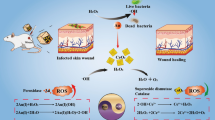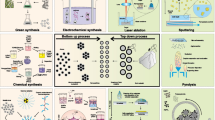Abstract
Influenza A virus (IFV-A) is one of the main cause of seasonal flu and can infect various of host species via the reassortment of segmented RNA genomes. Silver nanoparticles (AgNPs) have been known as excellent antiviral agent against IFV. However, the use of free AgNPs has several major drawbacks, including the inherent aggregation among AgNPs and unwanted cytotoxic or genotoxic damages for human body via inhalation or ingestion. In this study, we assessed the efficacy of our novel ~ 30-nm-diameter AgNP-decorated silica hybrid composite (Ag30-SiO2; ~ 400 nm in diameter) for IFV-A inactivation. Ag30-SiO2 particles can inhibit IFV-A effectively in a clear dose-dependent manner. However, when real-time RT-PCR assay was used, merely 0.5-log10 reduction of IFV-A was observed at both 5 and 20 °C. Moreover, even after 1 h of exposure to Ag30-SiO2 particles, more than 80% of hemagglutinin (HA) damage and 20% of neuraminidase (NA) activities had occurred, and the infection of Madin-Darby Canine Kidney (MDCK) cells by IFV-A was reduced. The results suggested that the major antiviral mechanism of Ag30-SiO2 particles is the interaction with viral components located at the membrane. Therefore, Ag30-SiO2 particles can cause nonspecific damage to various IFV-A components and be used as an effective method for inactivating IFV-A.






Similar content being viewed by others
References
Aigbogun NW, Hawker JI, Stewart A (2015) Interventions to increase influenza vaccination rates in children with high-risk conditions—a systematic review. Vaccine 33:759–770. https://doi.org/10.1016/j.vaccine.2014.12.013
Alswat AA, Ahmad MB, Hussein MZ, Ibrahim NA, Saleh TA (2017a) Copper oxide nanoparticles-loaded zeolite and its characteristics and antibacterial activities. J Mater Sci Technol 33:889–896. https://doi.org/10.1016/j.jmst.2017.03.015
Alswat AA, Ahmad MB, Saleh TA (2017b) Preparation and characterization of zeolite\zinc oxide–copper oxide nanocomposite: antibacterial activities. Colloid Interface Sci Commun 16:19–24. https://doi.org/10.1016/j.colcom.2016.12.00
AshaRani PV (2009) Cytotoxicity and genotoxicity of silver nanoparticles in human cells. ACS Nano 3:279–290. https://doi.org/10.1021/nn800596w
Aydin A, Cannon JL, Zhao T, Doyle MP (2013) Efficacy of a levulinic acid plus sodium dodecyl sulfate (SDS)-based sanitizer on inactivation of influenza a virus on eggshells. Food Environ Virol 5:215–219. https://doi.org/10.1007/s12560-013-9129-x
Balish AL, Katz JM, Klimov AI (2013) Influenza: propagation, quantification, and storage. Curr Protoc Microbiol Chapter 15:Unit 15G.1. doi:https://doi.org/10.1002/9780471729259.mc15g01s29
Genzel Y, Behrendt I, König S, Sann H, Reichl U (2004) Metabolism of MDCK cells during cell growth and influenza virus production in large-scale microcarrier culture. Vaccine 22:2202–2208. https://doi.org/10.1016/j.vaccine.2003.11.041
Harder TC, Vahlenkamp TW (2010) Influenza virus infections in dogs and cats. Vet Immunol Immunopathol 134:54–60. https://doi.org/10.1016/j.vetimm.2009.10.009
Hayashi K, Sagesaka YM, Suzuki T, Suzuki Y (2000) Inactivation of human type A and B influenza viruses by tea-seed saponins. Biosci Biotechnol Biochem 64:184–186. https://doi.org/10.1271/bbb.64.184
Herfst S, Schrauwen EJ, Linster M, Chutinimitkul S, de Wit E, Munster VJ, Sorrell EM, Bestebroer TM, Burke DF, Smith DJ, Rimmelzwaan GF, Osterhaus AD, Fouchier RA (2012) Airborne transmission of influenza A/H5N1 virus between ferrets. Science 336:1534–1541. https://doi.org/10.1126/science.1213362
Kandun IN, Samaan G, Harun S, Purba WH, Sariwati E, Septiawati C, Silitonga M, Dharmayanti NP, Kelly PM, Wandra T (2010) Chicken faeces garden fertilizer: possible source of human avian influenza H5N1 infection. Zoonoses Public Health 57:285–290. https://doi.org/10.1111/j.1863-2378.2009.01246.x
Khan SU, Saleh TA, Wahab A, Khan MHU, Khan D, Khan WU, Rahim A, Kamal S, Khan FU, Fahad S (2018) Nanosilver: new ageless and versatile biomedical therapeutic scaffold. Int J Nanomedicine 13:733–762. https://doi.org/10.2147/IJN.S153167
Ko YS, Joe YH, Seo MH, Lim KP, Hwang JH, Woo K (2014) Prompt and synergistic antibacterial activity of silver nanoparticle-decorated silica hybrid particles on air filtration. J Mater Chem B 2:6714–6722. https://doi.org/10.1039/C4TB01068J
Lara HH, Ayala-Nuñez NV, Ixtepan-Turrent L, Rodriguez-Padilla C (2010) Mode of antiviral action of silver nanoparticles against HIV-1. J Nanobiotechnol 8:1. https://doi.org/10.1186/1477-3155-8-1
Lara HH, Garza-Treviño EN, Ixtepan-Turrent L, Singh DK (2011) Silver nanoparticles are broad-spectrum bactericidal and virucidal compounds. J Nanobiotechnol 9:30. https://doi.org/10.1186/1477-3155-9-30
Lim MY, Kim JM, Lee JE, Ko GP (2010) Characterization of ozone disinfection of murine norovirus. Appl Environ Microbiol 76:1120–1124. https://doi.org/10.1128/AEM.01955-09
Li Q, Mahendra S, Lyon DY, Brunet L, Liga MV, Li D, Alvarez PJJ (2008) Antimicrobial nanomaterials for water disinfection and microbial control: potential applications and implications. Water Res 42:4591–4602. https://doi.org/10.1016/j.watres.2008.08.015
Lu L, Sun RW, Chen R, Hui CK, Ho CM, Luk JM, Lau GK, Che CM (2008) Silver nanoparticles inhibit hepatitis B virus replication. Antivir Ther 13:253–262
Mehrbod P, Motamed N, Tabatabaian M, Soleimani ER, Amini E, Shahidi M, Kheiri MT (2009) In vitro antiviral effect of nanosilver on influenza virus. DARU J Pharm Sci 17:88–93
Mori Y, Ono T, Miyahira Y, Nguyen VQ, Matsui T, Ishihara M (2013) Antiviral activity of silver nanoparticle/chitosan composites against H1N1 influenza A virus. Nanoscale Res Lett 8:93. https://doi.org/10.1186/1556-276X-8-93
Nelson MI, Holmes EC (2007) The evolution of epidemic influenza. Nat Rev Genet 8:196–205. https://doi.org/10.1038/nrg2053
Neumann G, Noda T, Kawaoka Y (2009) Emergence and pandemic potential of swine-origin H1N1 influenza virus. Nature 459:931–939. https://doi.org/10.1038/nature08157
Park HH, Park S, Ko G, Woo K (2013) Magnetic hybrid colloids decorated with Ag nanoparticles bite away bacteria and chemisorb viruses. J Mater Chem B Mater 1:2701–2709. https://doi.org/10.1039/c3tb20311e
Park S, Park HH, Kim SY, Kim SJ, Woo K, Ko G (2014) Antiviral properties of silver nanoparticles on a magnetic hybrid colloid. Appl Environ Microbiol 80:2343–2350. https://doi.org/10.1128/AEM.03427-13
Park S, Park HH, Ko YS, Lee SJ, Le TS, Woo K, Ko G (2017) Disinfection of various bacterial pathogens using novel silver nanoparticle-decorated magnetic hybrid colloids. Sci Total Environ 609:289–296. https://doi.org/10.1016/j.scitotenv.2017.07.071
Park S, Ko YS, Jung H, Lee C, Woo K, Ko G (2018) Disinfection of waterborne viruses using silver nanoparticle-decorated silica hybrid composites in water environments. Sci Total Environ 625:477–485. https://doi.org/10.1016/j.scitotenv.2017.12.318
Park SH, Ko YS, Park SJ, Lee JS, Cho J, Baek KY, Kim IT, Woo K, Lee JH (2016) Immobilization of silver nanoparticle-decorated silica particles on polyamide thin film composite membranes for antibacterial properties. J Membr Sci 499:80–91. https://doi.org/10.1016/j.memsci.2015.09.060
Schulze-Horsel J, Genzel Y, Reichl U (2008) Flow cytometric monitoring of influenza A virus infection in MDCK cells during vaccine production. BMC Biotechnol 8:1–12. https://doi.org/10.1186/1472-6750-8-45
Soares T, Ribeiro D, Proenca C, Chiste RC, Fernandes E, Freitas M (2016) Size-dependent cytotoxicity of silver nanoparticles in human neutrophils assessed by multiple analytical approaches. Life Sci 145:247–254. https://doi.org/10.1016/j.lfs.2015.12.046
Swayne DE (2006) Microassay for measuring thermal inactivation of H5N1 high pathogenicity avian influenza virus in naturally infected chicken meat. Int J Food Microbiol 108:268–271. https://doi.org/10.1016/j.ijfoodmicro.2005.08.032
WHO (2018) Fact sheet of influenza (Seasonal). http://www.who.int/en/news-room/fact-sheets/detail/influenza-(seasonal). Accessed 24 May 2018
WHO (2017) Influenza. http://www.who.int/biologicals/vaccines/influenza/en/. Accessed 24 May 2018
Yamamoto Y, Nakamura K, Okamatsu M, Yamada M, Mase M (2008) Avian influenza virus (H5N1) replication in feathers of domestic waterfowl. Emerg Infect Dis 14:149–151. https://doi.org/10.3201/eid1401.071036
Zepeda C, Salman MD (2007) Assessing the probability of the presence of low pathogenicity avian influenza virus in exported chicken meat. Avian Dis 51:344–351. https://doi.org/10.1637/7567-033106R.1
Zhang C, Hu Z, Deng B (2016) Silver nanoparticles in aquatic environments: physiochemical behavior and antimicrobial mechanisms. Water Res 88:403–427. https://doi.org/10.1016/j.watres.2015.10.025
Acknowledgements
This work was supported by a National Research Foundation of Korea (NRF) grant funded by the Korean government (MSIP) (no. 2013-069335) and the Korea Institute of Planning and Evaluation for Technology in Food, Agriculture, Forestry, and Fisheries (IPET) through a High Value-added Food Technology Development Program funded by Ministry of Agriculture, Food, and Rural Affair (MAFRA) (315067-3).
Author information
Authors and Affiliations
Corresponding author
Additional information
Responsible editor: Philippe Garrigues
Rights and permissions
About this article
Cite this article
Park, S., Ko, YS., Lee, S.J. et al. Inactivation of influenza A virus via exposure to silver nanoparticle-decorated silica hybrid composites. Environ Sci Pollut Res 25, 27021–27030 (2018). https://doi.org/10.1007/s11356-018-2620-z
Received:
Accepted:
Published:
Issue Date:
DOI: https://doi.org/10.1007/s11356-018-2620-z




